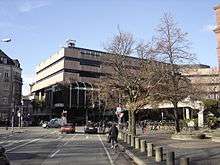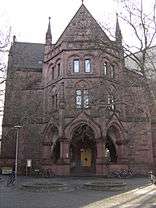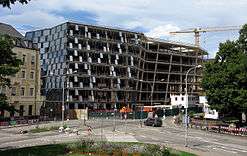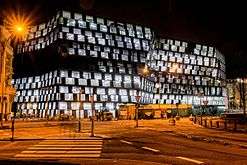University Library Freiburg
The University Library Freiburg (German Universitätsbibliothek Freiburg, UB) is the library of the University of Freiburg. As an academic and research library, the University Library caters to students and staff of the University of Freiburg, the University of Education Freiburg, the Catholic University of Applied Sciences Freiburg, and the Protestant University of Applied Sciences Freiburg. The library is open to interested members of the public as well.
_jm33894.jpg)
History


When the University of Freiburg was founded in 1457 the libraries were most commonly attached to the respective faculties. The term „biblioteca universitatis“ was used for the first time in 1505 in protocols of the university's Academic Senate probably for the faculty of arts library. Besides the faculty's book-collection, its different Burses (medieval predecessors of student halls) and so called "Stiftungshäuser" (student housing maintained by endowments) were of great importance for the students (Domus Cartusiana, 1485; Collegium Sapientiae Collegium Sapientiae Freiburg 1496 and in the 16th century Collegium Battmanicum, Collegium S.Galli and Collegium Pacis). Endowments were important to the library's accretion as well, particularly in its early years. Maria Theresia's Maria Theresa reforms constitute the background of the above-mentioned arrangements and increasingly influenced the library's acquisition policies as well. In 1755, the various libraries were finally joined to form a common library and a new hall was constructed to house the inventory of books.A full-time librarian worked there from 1768. The abolition of the Catholic order Society of Jesus in 1773 marked the end of the Jesuit presence at the university. The Jesuit order had been in charge of large parts of the university since 1620. Due to the suppression of the order, large collections of books from Jesuit libraries were transferred to University of Freiburg, leading to a rapid expansion of the University Library's stock. In 1791 the grammar school moved to the Brunnenstraße and would later become the "Berthold grammar school". The library remained at its location. The secularization and reforms introduced by Emperor Joseph II of Austria subsequently caused the disbandment of several monasteries, further contributing to the increase in books.
The creation of a commission dedicated to acquiring literature in 1795 as well as the professionalization of the library direction led to a continuing prosperous growth of the library and its inventory. After the library had moved into a gothic revival building in 1903, numerous reforms to the organization were enacted. The executives Emil Jacobs (1912-1929) and Josef Rest (1929-53) undertook several reforms concerning the library's organisational system: in 1924 an interlibrary loan system service (ILL) of southern German libraries, a system for acquiring specialist literature, indexing and a consulting service were set up. In 1932, a collection of natural scientific and medical textbooks were acquired, further the so-called "Preußische Instruktionen" (a system of rules for libraries)Preußische Instruktionen helped to bring forward the alphabetical categorisation and participation on establishing the German general catalogue from 1931 until its destruction during the second world war World War II. Various publications and exhibitions showed a new emphasis on public presence. On top, use of the library was further improved by funding exhibitions and publications, thus PR. During Nazi Germany, the University Library like the University of Freiburg itself complied with the racist laws and censorship of the regime. Due to the timely evacuation of many of books, the library was able to prevent the destruction of large quantities of its inventory during World War II, despite significant damage to the library building. The post-war years are characterized by reconstruction and the reorganization as well as expansion of the library's stock.
A new building was constructed in 1978 to house the library and its inventory, which by now had grown to become very extensive. New catalogs were introduced and a university library system including faculty libraries was implemented. In recent years, the expansion of digital volumes and new media has been a focus of the development of the University Library Freiburg. The podcasting service offered by the library was selected as a landmark in the initiative Germany - Land of Ideas sponsored by the German government and the Federation of German Industries.
The first hall serving as location for the University Library mentioned above was expanded in 1822 to ensure its continuous use. In 1903, the library moved to a gothic revival building, which is today known as the Kollegiengebäude IV (KG IV). In 1978, the University of Freiburg constructed a new building across from the Kollegiengebäude II and next to the Freiburg Theater.
Current Building

The library had to be renovated primarily because the technology that was used in the building, e.g. the air conditioning system, was outdated, and because the front was damaged. The reconstruction of the library was intended to save money in the management of the building. The library is also supposed to integrate into the city's urban development concept. In early 2006, the reconstruction was initiated by an architectural design competition. The winner was Degelo Architekten, an architecture firm from Basel. Initially, the costs were estimated at 32 million Euros. The newly constructed building holds 1,200 workspaces in four reading rooms as well as 500 work areas in the parlatory. At the same time it is supposed to save 60 to 70% of the energy costs of the former building, about 700,000 Euros per year.[1]
Between fall 2008 and July 2015, the University Library was moved to two temporary quarters: the UB 1 (University Library 1) was in the former civic hall and the UB 2 (University Library 2) was located on the street Rempartstraße. Due to the temporary move of the library, the UB 1 (in the former city hall) initiated 24/7 opening hours.This was maintained in the new building. In September 2009, the pedestrian bridge, which was situated next to the old library, was torn down. In the following months, the building was freed from harmful substances, electronics and carpets.
Starting in January 2011, the old building was rebuilt. Different than originally planned, only three stairwells were not destroyed after the partial demolition of the aboveground part of the building. The extent of this demolition process was far bigger than previously planned. On the one hand, more contaminated material had to be disposed of. On the other hand, the previously planned addition to the existing ceilings would not have fulfilled the new earthquake norms.[2] For that reason, the ceilings had to be renewed completely. The three basements with storage space for books were preserved. During the reconstruction the storage space was further used, and 3.5 million books were accessible further on. The tear down of the building was done in December 2011, after which the shell was built. In October 2012, while building the shell, it became public that the renovation would exceed the planned cost of 44 million euros. On 10 November 2012, a construction worker died on the site of the new University library because he fell from the scaffolding. The shell was completed in April 2013.

In the same month, interior construction began, as well as the installation of a 7,300 m² facade of glass and matted, dark chrome steel.[3] In April 2014, the front was completed. Its paneling was not finished until shortly before the opening in July. In addition to this mishap, the company which was supposed to be responsible for all of the building services went bankrupt.[4] Further difficulties with the building include the fact that traffic participants are blinded by the reflections on the southeastern corner of the glass front when the sun is low in spring and fall. For this reason, canvas blinds are used to cover it during these times.[5]
The new university library began test operation on 21 July 2015, almost two years after initially planned. During this phase the building services, book drop, WiFi, guidance systems and other procedures were being optimized.[6] On 12 October 2015, the library was officially handed over to the university in the presence of two federal ministers.[7] Construction in total then cost 53 million euros.[8][9] Initially, the library was planned to open in the fall of 2013. Then, "mid- 2014"[10] was announced as an opening date, which was shortly thereafter replaced by "late 2014".[3]
The central concept behind the building's design was to have workspaces around the exterior of each floor with books stored in the center. After a successful test phase, 24/7 opening hours were maintained. The new building is 20% smaller in volume than the previous building; however, it offers a net floor area that is 30,600 m² greater than the previous building and a total of 1,700 workspaces. The building is organized as follows:
- On the ground floor, a book drop and information counter, as well as lockers, are located on the southern side (near Belfortstrasse) and on the northern side, you can find Cafe Libresso with a terrace extending to the Platz der Alten Synagoge.
- For every floor above the second floor, the floors are divided into two sections: On the southern side, there are reading rooms (numbered 1 to 4 in accordance with the floor number) where the permanent collection can be accessed. This side of the library is dedicated to quiet work. The northern side features a parlatory where group work is encouraged. This area features display screens and speaking is allowed. You can only pass from one side to the next via the ground floor, as the two sections on each floor above that one are divided by a glass wall.
- The southern side of the third floor is home to the law school, which used to be located in the university building KGII (Kollegiengebäude II). The reading room for these students is located on the fifth floor of the library.
- The north side of the building also features an auditorium for up to 200 people on the second floor, classrooms on the third floor, a media center on the fourth floor, and public access computers on the fifth floor.
- The sixth floor is home to the library administration department and the seventh floor houses the building services.
- The first basement floor features automated checkout machines and 700,000 volumes that can be borrowed, as well as a bicycle garage that can store up to 400 bikes.[11]
- There are two floors beneath this first basement floor that serve the purpose of storage for the permanent collection. These books can be ordered and checked out as well.[12]
Volumes and media
With an inventory of approximately 3.6 million volumes, the University Library Freiburg is one of the largest libraries in the state of Baden-Württemberg. In 2007, the library saw over 2 million borrowings by around 36,000 active users.[13]
References
- "44 Millionen Euro für die neue Unibibliothek". Südwest Presse. 27 April 2011. Archived from the original on 24 September 2015. Retrieved 3 November 2014.
- Frank Zimmermann (28 December 2014). "Neue UB in Freiburg wird eingerichtet – Kosten und Eröffnung weiter unklar". Badischer Verlag GmbH & Co. KG. Retrieved 19 February 2015.
- Frank Zimmermann (16 May 2013). "Architekt Degelo: Erwarte keine negativen Reaktionen auf die neue UB". Badischer Verlag GmbH & Co. KG. Retrieved 16 January 2014.
- "Freiburg: Großbaustelle: Firmenpleite auf der UB-Baustelle – Fassade fast geschlossen - badische-zeitung.de". Retrieved 4 April 2014.
- "Freiburg: Sonnenstrahlen: Fassade der Freiburger UB blendet zu sehr – Banner müssen aufgehängt werden - badische-zeitung.de". Retrieved 9 May 2014.
- "Universitätsbibliothek Freiburg: Noch im Probebetrieb". Retrieved 21 July 2015.
- "Festakt für die Universitätsbibliothek – Öffentlichkeitsarbeit und Beziehungsmanagement". Retrieved 13 October 2015.
- "Am 21. Juli soll die neue UB in Freiburg eröffnen - wenn alles gut geht - fudder • neuigkeiten aus freiburg: Stadtgespräch". Archived from the original on 13 June 2015. Retrieved 9 June 2015.
- "Fotos: So chic sieht die neue UB von innen aus! - fudder • neuigkeiten aus freiburg: Stadtgespräch". Archived from the original on 18 June 2015. Retrieved 9 June 2015.
- Frank Zimmermann (11 October 2012). "Unibibliothek Freiburg wird erst Mitte 2014 fertig – und wohl teurer". Badischer Verlag GmbH & Co. KG. Retrieved 3 November 2014.
- "Universitätsbibliothek Freiburg: Architektur". Retrieved 22 September 2015.
- Carolin Buchheim (4 February 2014). "Baustellenbesuch: Wie die UB von Innen aussieht". fudder. Archived from the original on 2 February 2015. Retrieved 2 February 2015.
- http://www3.ub.uni-freiburg.de/index.php?id=60
